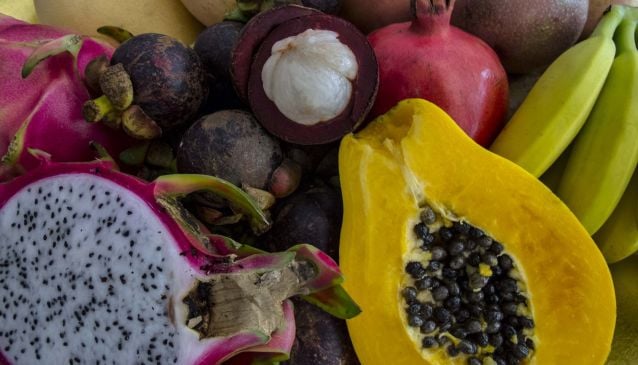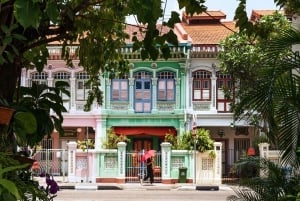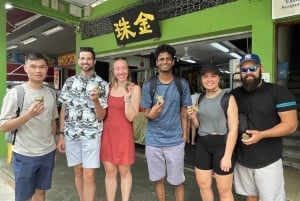Fruit For Thought
Some consider the scent as fragrant, others compare it fermenting garbage...
Book Top Experiences and Tours in Singapore:
If youʻre booking your trip to Singapore last minute, we have you covered. Below are some of the top tours and experiences!- Singapore: Highlights and Hidden Gems Private Car Tour
- Singapore: Guided Boat Tour and Kelong Fish Farm Visit
- Singapore: Katong Local Food and City Highlights Tour
- Singapore: Sentosa Cable Car Sky Pass Roundtrip Ticket
- Singapore: Marina Bay Sands Observation Deck E-Ticket
Elizabeth Kain for My Guide Singapore
Located just one degree north of the equator, offers a cornucopia of fresh, tropical fruit. From those well known to westerners, such as mangos, to those offering a bit more adventure, like longevity fruit – each are worth exploring. On your next trip to Singapore, be sure to add these exotic, delicious treats to your itinerary.
The most notorious tropical fruit is probably the durian. Identified by its pungent odor long before you lay eyes on its spikey husk, a durian can repulse before you ever take a bite. While some consider the intense scent fragrant, others compare it to that of fermenting garbage or old gym clothes. For this reason and because the odor will escape even airtight containers, it is banned on all public transport in Singapore. If you can make it past the strong aroma, the texture of the deep yellow flesh similar to a ripe avocado – will – at the very least - make you a member of the club of those who have tried durian.
Geylang, an area in the eastern part of Singapore, is famous for its durian stalls, yet you will rarely find the fruits in a supermarket or wet market. Singaporeans have even incorporated their signature fruit into the design of one of the most important attractions: the Esplanade Concert Hall.
Another fragrant and well-liked fruit is the jackfruit. In this case,the distinct smell belies the fruit’s mild and sweet flavor. The intense yellow color of the soft flesh reminds of that of the durian. Jackfruit grows on trees to be bigger than a watermelon with a rough, greenish skin. At the wet market, the fibrous fruit is usually pre-packaged in ready-to-eat portions. At the supermarket, it can also be found dried with a chip-like texture as a great and healthy snack.


The name of the rambutan in Malay means “hairy” and with its shaggy reddish-green exterior one can understand the reason. Often a favorite among those new to the tropics the rambutan delights with white meat that is sweet, delicious and juicy.
Originally from Central America, the dragon fruit boasts a dramatic red-colored exterior with cropped greenish shoots and is widely available in Singapore. Bland in flavor, this fruit grows on a cactus and has either a red or white center. The small black seeds add to its beauty and offer an appealing texture to an otherwise mild flavor.
The only thing the mangosteen has in common with the mango is that they are both found in abundance throughout Southeast Asia. The thick, deep purple skin of the mangosteen can be broken open to reveal small white sections, which are sweet and delicious to taste. Known as the “queen of all fruits” the mangosteen is refreshing, juicy and usually delights everybody.
Tropical fruit novices may initially mistake the longan for a lychee. They are similar in size and shape and even the white meat inside appears the same. Yet on closer examination, the longan, is slightly smaller and has a smooth light brown skin versus the reddish, rough exterior of the lychee. Where they truly differ, however, is in the taste. The small longan’s white meat is almost translucent and much sweeter than that of the lychee, which a local once described as “citrus with a hint of peach.” Why not try both and see which one you prefer?


Contrary to what its name implies, a soursop’s creamy white center is slightly chewy and offers a wonderful blend of sweet and tart. This thorny green-colored fruit, which can weight over five pounds, is native to the tropical zones in South America and Africa but today is widely found in Southeast Asia. Despite its scaly appearance and unfortunate name, the soursop is worth a taste and delights also as refreshing juice to be found freshly squeezed at food courts.
You may mistake a guava for a green pear or apple at an Asian market. While its appearance and texture is similar to these familiar western fruits, the guava is sweet with a slight bitter flavor. You’ll often find it served as a juice on menus. If you are craving western fruit, why not try the custard apple, which resembles a large, misshapen, green-colored, bud. It gets its name from its subtle texture and taste – a blend of traditional custard with a hint of apple.
Finally, the longevity fruit is the only fruit mentioned here that is only eaten when dried.Resembling a kiwi in color, size and appearance, it boasts a green, fuzzy skin while on the tree. When dry and ready to eat, it is brown and light as a feather. To consume, you simply break the thin skin to find small fibrous pods that offer a taste reminiscent of licorice. You may also suck on the skin for a sweet, distinct and refreshing flavor.


Now that your palate is tempted, you are ready to explore Singapore’s bounty of tropical fruits. Here are some tips to help get you started:
- All fruits mentioned have skins or husks. To eat, you simply peel or cut open and eat the meat inside.
- You may find tropical fruits at any grocery store, but the country’s wet markets provide a significantly larger selection (Tekka Market at 665 Buffalo Road / Little India is a good place to start).
- Ask shopkeepers for help in determining which fruit are ripe for that day and which require a few days to become sweet. They will also tell you how to store these fruit until they are ready to eat.
- At grocery stores, most fruit will be pre-packaged. At the market you can purchase larger items by the piece and smaller pieces by weight (1 pound is roughly equivalent to a half kilo)
- Most shopkeepers will speak English so feel free to ask questions or even request a sample.
- Longevity fruits are generally not found at markets. Your best bet is to try a Chinese shop offering dried goods or medicinal products in Chinatown.
Enjoy your tasty adventure!

















